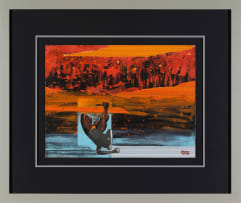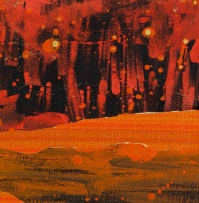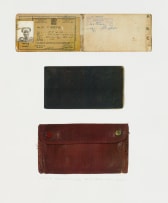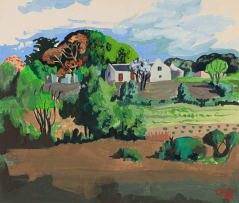Peter Clarke
Icarus
About this Item
signed and dated Jan. 1981
Notes
Ovid re-spun the story of Icarus and Daedelus in the Metamorphoses, his epic and mythological poem. The narrative described how the Athenian Daedelus, a master craftsman, built the Labyrinth for King Minos of Crete from which the Minotaur could not escape. Detained on the island himself, along with his son Icarus, Daedelus fashioned ingenious wings of wax and feathers to help the two fly to freedom. While fixing the wings to his son's arms, Daedelus issued a warning: fly too low and the damp will weigh down the feathers, fly too high and the sun will melt the wax that holds them. Increasingly elated and cocksure during his flight, Icarus soared nearer and nearer the sun, eventually scorching his wings and plummeting to his death. It was tragic hubris that caused his fall. While the flight of Icarus has moved artists from Pieter Brueghel the Elder to Jacob Peter Gouwy and Henri Matisse, Peter Clarke's visual version of the myth is particularly intriguing in its technique, references and symbolism. If torn strips of paper and card, painted in degrees of blistering orange and red, suggest a looming sun, then layers of white and inky blue on the bottom margin evoke the sea below. Clarke's Icarus figure is made up of unusual parts: the heavy and muscular legs bring to mind Michelangelo's ignudi on the Sistine Chapel ceiling, but the torso, arms and head come from a contemporary photograph, seemingly of a youth or objector shielding himself from a blow. This element allows the work to be read in a specifically South African context, and seems to raise politically-loaded questions around oppression, exile, freedom and
activism. Does Clarke's Icarus suggest that it might be hubris to stand up to social injustice in a police state? Were apartheid dissenters flying too close to the sun? Clarke continued to play with tropes of flight, freedom and resistance in the early 1980s. This thematic focus culminated in Homage, one of the artist's most widely-quoted images, which incorporated some lines from the activist poet Langston Hughes: 'Hold fast/to dreams/for if/dreams die/life is a/broken winged/bird/that cannot fly'.












